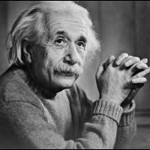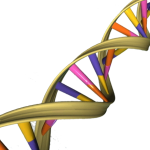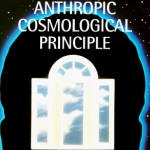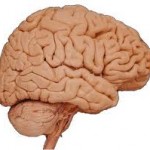“Intelligent Design” is merely the idea that some things in nature, as well as possibly all of nature itself, surely seems to have, well, intelligent design behind it. The theory goes like this: If you were walking on the beach and found a watch, you could basically go in one of two directions: (1) you could marvel at how something like this came together all by itself, over time, with one jaw-dropping chance happening after another, or (2) you would assume someone, somewhere, had manufactured this thing. While Intelligent Design (known as “I.D.” in the lingo world) certainly doesn’t answer all the questions and fill in all the spaces, but it does provide for intriguing discussion.
 Albert Einstein is quoted to have said, “The most incomprehensible fact about the universe is that it is comprehensible.” That’s the point: the universe actually has order and structure, and shows, well, design. For a totally random chance structure, that’s pretty impressive. The thoughts of Intelligent Design are that maybe it makes more sense that there design instead of just chance.
Albert Einstein is quoted to have said, “The most incomprehensible fact about the universe is that it is comprehensible.” That’s the point: the universe actually has order and structure, and shows, well, design. For a totally random chance structure, that’s pretty impressive. The thoughts of Intelligent Design are that maybe it makes more sense that there design instead of just chance.
Science ought to be a search for the truth about the world, and objectively we shouldn’t prejudge what might be true. We shouldn’t say, “I don’t like that explanation” and ignore it. Instead, when we come to a puzzle in nature, we ought to bring to that puzzle every possible cause that might explain it. Makes sense to me. That’s what science is all about. But evolutionary theory artificially rules out a kind of cause—intelligence—before it even has a chance to speak. Methodological naturalism limits itself to explanations that invoke only natural causes because that is its presupposition and its bias. Yet curiously, we make inferences to intelligence all the time as part of our ordinary reasoning. When we find hieroglyphics on stones, no one says, Wow, look what erosion did!” Instead, we recognize them as the work of ancient scribes—intelligent human agents. Similarly, we do not attribute the statues on Easter Island to have been formed by wind and water over great periods of time. We make these inferences all the time, and of course they’re correct. If you travel through the West, you’ll find many rocks taking familiar shapes. But in South Dakota, you’ll see the faces of four presidents. Same thing: We all assume those patterns aren’t there naturally or by chance, but by intelligence. We know they match the portraits we have from history.
On another front, we also recognize that information-rich systems originate from intelligence. Then let’s take that  same principle and apply it elsewhere: Where does an information-rich system like DNA come from? There is no known natural process that produces information.
same principle and apply it elsewhere: Where does an information-rich system like DNA come from? There is no known natural process that produces information.
The simple mathematical form that nature takes can be construed as evidence of design rather than chance. The universe is adequately described by such a small number of fundamental physical laws (Newton’s Laws of Motion, Laws of Thermodynamics, Maxwell’s equations of electricity and magnetism), represented by simple but elegant mathematical relationships, that they can be easily written on one side of one sheet of paper. “The equations of physics have in them incredible simplicity, elegance, and beauty.” [1]
So, does the universe show evidence of intelligent design? Many think it does. For instance, look at precision and probability. The “coincidence” that the physical constants in the universe are precisely what is needed for life to exist is evidence of design rather than chance. “For example, if the electric charge of the electron had been only slightly different, stars would have been unable to burn hydrogen and helium, or else they would not have exploded … It seems clear that there are relatively few ranges of values for the numbers (for the constants) that would allow for development of any form of intelligent life. Most sets of values would give rise to universes that, although they might be very beautiful, would contain no one able to wonder at that beauty.” [2]
 The classical book which covers extensively how the values of the physical constants in the universe are so fine-tuned that small variations in them would lead to a universe incompatible with life was discussed by John D. Barrow and Frank J. Tipler in The Anthropic Cosmological Principle (Oxford University Press, 1986):
The classical book which covers extensively how the values of the physical constants in the universe are so fine-tuned that small variations in them would lead to a universe incompatible with life was discussed by John D. Barrow and Frank J. Tipler in The Anthropic Cosmological Principle (Oxford University Press, 1986):
A. The strongest of all the forces in nature is called the “strong nuclear force” that holds the nuclei of atoms together (to prevent them from blowing apart). If the strong nuclear force was 5% weaker, hydrogen would be the only element with a stable nucleus, and nature would lack the chemical complexity necessary for life. If the strong nuclear force was 2% stronger, the nuclei which would form would be very massive and unsuitable for living organisms; there would be no stable hydrogen, no hydrogen-containing compounds (thus no organic-based life), and no long-lived stars.
B. In nature, the strong nuclear force is about 100 times as strong as electromagnetic forces. Slight variation in this ratio would lead to no quantum levels to allow efficient conversion of beryllium to carbon, or partial conversion of carbon to oxygen. We either get a beryllium rich or oxygen rich universe, and carbon would be sparse. Yet all life as we know it is based on the element of carbon. So if the universe were deficient in carbon, how else would it come into existence? Carbon is unique among the elements because it has the ability to chemically bond with itself and other elements in a vast number of arrangement, with bonds that are stable, but not so stable as to greatly restrict chemical transformations (reactions).
C. The ratio of proton to electron mass is 1836 to 1. If that ratio was larger or smaller, no molecules would form.
D. The ratio of the electromagnetic force to gravity (~1035) is precisely right for a star to be stable. Also, it takes an enormous amount of mass to make gravity dominate electromagnetism (Newton’s apple).
E. Our sun is exactly the right mass. If it were heavier, it would produce too much radiation for DNA to withstand. On the other hand, if there were less mass, then the range around the sun where liquid water could exist would be narrow (and be closer to the sun than Earth is).
You’re getting the point. I.D. speculates that the initial conditions were exactly what were needed for the formation of the universe, and that is evidence of design rather than chance.
“For extravagant implausibility … nothing in theology can hold a candle to what science says about the Big Bang. From a pinpoint of compressed potential—‘a microscopic, transparent, empty point in primordial space-time’ – it sent a cosmos hurtling outward at an unimaginable speed. The forces loosed were—are—remarkably (miraculously?) balanced: if the Big Bang had been slightly less violent, the expansion of the universe would have been less rapid, and would soon (in a few million years, or a few minutes—in any case, soon) have collapsed back on itself. If the explosion had been slightly more violent, the universe might have dispersed into a soup too thin to aggregate into stars. The odds against us were—this is just the right word—astronomical. The ratio of matter and energy to the volume of space at the Big Bang must have been within about one quadrillionth of 1 percent of ideal … Life is so improbable it must somehow be favored by something.” [3]
“If electrostatic forces—the magnetic attraction between a single proton and a single neutron—was just one percent different from what it actually is, the conditions for life as we know it would not exist.” [4]
 Astronomer Chet Raymo says, “If, one second after the Big Bang, the ratio of the density of the universe to its expansion rate had differed from its assumed value by one part in 1015, the universe would have either quickly collapsed upon itself or ballooned so rapidly that stars and galaxies could not have condensed from the primal matter.” [5]
Astronomer Chet Raymo says, “If, one second after the Big Bang, the ratio of the density of the universe to its expansion rate had differed from its assumed value by one part in 1015, the universe would have either quickly collapsed upon itself or ballooned so rapidly that stars and galaxies could not have condensed from the primal matter.” [5]
In 1997, astronomers learned from the work of Adam Reiss that the universe is accelerating. A mysterious energy is pushing apart galaxies and space itself. This “dark energy” is so pervasive that it makes up 76% of all the mass energy in the universe. Efforts to explain what dark energy is—where it comes from, what generates it—are showing that the craziest ideas in astronomy pale next to what is true in nature. Theories of its source range from a sea of subatomic particles (Einstein’s theory of the cosmological constant) to gravity leaking out of our universe. Other cosmologists speculate that our universe is only one of many, each of which could have different features. In our universe, though, the improbable cancellation of Einstein’s theory about subatomic particles would have occurred, leaving just enough to explain the dark energy. As for why we happen to be living in that improbable universe: only this feature allows galaxies for form and life to emerge. Astronomers can yet begin to explain why the cosmological constant is just the right size to account for dark energy, and hence for life in our universe.” [6]
 Now let’s turn our attention to something else: the human brain. No one has yet proposed a credible random process that could produce the brain. The adult human brain consists of about 10 billion nerve cells and contains over 1014 (a hundred thousand billion) electrical connections, more than all the electrical connections in all the electrical appliances in the world.
Now let’s turn our attention to something else: the human brain. No one has yet proposed a credible random process that could produce the brain. The adult human brain consists of about 10 billion nerve cells and contains over 1014 (a hundred thousand billion) electrical connections, more than all the electrical connections in all the electrical appliances in the world.
Most lower forms of life do not have a brain, but even the single-cell amoeba has a primitive sensing system that enables it to avoid harmful stimuli. All vertebrates, however, possess a brain composed of the same three basic subdivisions found in the human brain: hindbrain, midbrain, and forebrain. The size of the brain does not determine the degree of intelligence. What is most responsible for guiding the behavior of the animal is the intricate circuitry of the nerve fibers within it.
“The probability of dust carried by the wind reproducing a major literary work is less infinitesimal than the probability of copy errors in the DNA molecule leading to the formation of the eye; besides, these errors had no relationship whatsoever with the function that the eye would have to perform or was starting to perform. There is no law against daydreaming, but science must not indulge in it.” [emphasis in original] [7]
“For the eye to work it must be clean and moist. Light passes through the protective outer coating (the cornea) and continues via a self-adjusting aperture (the pupil) to a similarly automatic lens, which focuses it on the back of the retina. Here 130 million light-sensitive rods and cones cause photochemical reactions that transform the light into electrical impulses. These are then transmitted to the brain at terrific speed. How is it possible that thousands upon thousands of lucky mutations happened coincidentally so that the lens and the retina—which cannot work without each other—evolved in synchrony?” [8]
It must be admitted, however, that it is a considerable strain on one’s credulity to assume that finely balanced systems such as certain sense organs (the eye of vertebrates, or the bird’s feather) could be improved by random mutations. This is even more true for some of the ecological chain relationships (the famous yucca moth case, and so forth.) [9]
Another principle of Intelligent Design is the thought of irreducible complexity. It’s the idea that in a system there are multi-component parts, all of which are necessary for function. If you lost one part in any way, you lost the whole. (A common mousetrap is a good simple illustration of irreducible complexity. Lose any one of the five components—spring, the catch, a thin bent rod, a holding bar, and a platform—and the trap cannot function.) In evolutionary terms, one must explain how you can build such a system gradually, without all the components totally in place. Darwin says, “Natural selection is scrutinizing the slightest variations, rejecting those that are bad, preserving and adding up all that are good.” Let’s take the example of the bacterial flagellum.
 The cell is far more complex than the science of Darwin’s day could have dreamed. There are elaborate microscopic worlds. At the very basis of life, we have discovered molecular “machines.” They regulate all of the functions of the body. For instance, the bacterial flagellum has a “propeller,” a hook region, a “drive-shaft,” and a “motor.” It’s like a microscopic outboard motor. Is it a chance assemblage of parts? The molecular “motors” that drive bacteria through liquid each depend on a system of intricately arranged “mechanical” parts. They are a marvel of engineering on a miniaturized scale. They have a large number of parts for the “motor” to work. How can a rotary motor have arisen through natural selection? How could something new like a bacterium flagellum motor and all the components that go with it—how could it develop out of a population of bacteria that don’t have that system, when each change according to Darwin’s theory has to provide some kind of advantage? There is no detailed Darwinian explanation.
The cell is far more complex than the science of Darwin’s day could have dreamed. There are elaborate microscopic worlds. At the very basis of life, we have discovered molecular “machines.” They regulate all of the functions of the body. For instance, the bacterial flagellum has a “propeller,” a hook region, a “drive-shaft,” and a “motor.” It’s like a microscopic outboard motor. Is it a chance assemblage of parts? The molecular “motors” that drive bacteria through liquid each depend on a system of intricately arranged “mechanical” parts. They are a marvel of engineering on a miniaturized scale. They have a large number of parts for the “motor” to work. How can a rotary motor have arisen through natural selection? How could something new like a bacterium flagellum motor and all the components that go with it—how could it develop out of a population of bacteria that don’t have that system, when each change according to Darwin’s theory has to provide some kind of advantage? There is no detailed Darwinian explanation.
The important thing to realize about natural selection is that it selects only for a functional advantage. In most cases, natural selection actually eliminates things that have no function or that have a function that harms the organism. So if you had a bacterium with a tail that didn’t function as a flagellum, chances are natural selection would eliminate it. The only way you can select for a flagellum is if you have a flagellum that works, and that means you have to have all the pieces in place in the first place. It is irreducibly complex. It points to intelligent design. The contrasting theory of co-option—that evolution at some point was able to borrow some components of another molecular machine and build a new machine with some of these components—is inadequate to explain how a machine such as the bacterial flagellum, with about 40 components (10 of which are seen elsewhere, and 30 of which are completely unique) could have come to be. The co-option theory cannot explain the construction, assembly, or function of the bacterial flagellum. [11]
Then there is something as “simple” as an egg shell. “Evolution cannot account for the astonishingly complex synchronization process needed for the shell of a developing egg to form from the calcium that is stored inside the bones of a bird’s body. This shell not only provides a protective covering for the egg but also provides a source of calcium for the developing embryo and a membrane through which it can breathe.” [12]
What about blood clotting? Blood clotting is one of those biochemical systems that is so complex, if any component was missing, the system would have no function. It is a complex, multi-step process that utilizes numerous proteins, many with no other function besides clotting. It also falls into the category of irreducibly complex. Which evolved first—the protein or the enzyme, both of which are necessary for clotting? Not the protein; it can’t function without the enzyme to switch it on. But why would nature evolve the activating enzyme first, for without the protein it serves no purpose whatsoever? Furthermore, if blood clotting had evolved step-by-step, slowly over the eons, creatures would have bled to death before it was ever perfected. The system is irreducibly complex.
Other Evidences
In the geologic record, species appear completely developed, not partially developed. There are no examples of half-developed feathers, eyes, skin, tubes (arteries, veins, intestines, etc.) or any of thousands of other vital organs. Tubes that are not 100% complete are a liability; so are partially developed organs. For example, if a leg of a reptile were to evolve into the wing of a bird, it would become a bad leg long before it became a good wing. [13]
“Consider plain old tap water. The solid state of most substances is denser than their liquid state, but the opposite is true for H2O, which explains why ice floats rather than sinks. If water were like virtually any other liquid, it would freeze from the bottom up rather than from the top down, killing aquatic life, destroying the oxygen supply, and making earth uninhabitable.” [14]
“Ocean tides, which are caused by the gravitational pull of the moon, play a crucial role in our survival. If the moon were significantly larger, thereby increasing its gravitational pull, devastating tidal waves would submerge large areas of land. If the moon were smaller, tidal motion would cease and the oceans would stagnate and die.” [15]
A new book by Steven Strogatz [16] attempts to answer the question of intelligent design. He argues that the universe is an orderly place marked by harmony and cooperation, thanks to intrinsic properties that emphasize teamwork and synchrony from that atomic level up. His illustrations include the aquatic ballet of schools of fish, fireflies blinking in rhythm, and even the neurons of the brain acting as an orchestra. He argues that sync is embedded in the rules of nature—rules we’ve never been able to figure out with calculations, nor sometimes even observation. He says that “the entire universe may carry the seeds of its own order.” So here is another possibility (remember that the best science looks at all the options, not just the ones you agree with), but how much credibility this has by the pure chance of evolution has to be evaluated.
 Says Paul Davies, a mathematical physics professor: “I belong to a group of scientists who do not subscribe to a conventional religion but nevertheless deny that the universe is a purposeless accident. Through my scientific work I have come to believe more and more strongly that the physical universe is put together with an ingenuity so astonishing that I cannot accept it merely as a brute fact. There must, it seems to me, be a deeper level of explanation. Whether one wishes to call that deeper level “God” is a matter of taste and definition. Furthermore, I have come to the point of view that mind, i.e., conscious awareness of the world, is not a meaningless and incidental quirk of nature, but an absolutely fundamental facet of reality. That is not to say that we are the purpose for which the universe exists. Far from it. I do, however, believe that we human beings are built into the scheme of things in a very basic way.” [17]
Says Paul Davies, a mathematical physics professor: “I belong to a group of scientists who do not subscribe to a conventional religion but nevertheless deny that the universe is a purposeless accident. Through my scientific work I have come to believe more and more strongly that the physical universe is put together with an ingenuity so astonishing that I cannot accept it merely as a brute fact. There must, it seems to me, be a deeper level of explanation. Whether one wishes to call that deeper level “God” is a matter of taste and definition. Furthermore, I have come to the point of view that mind, i.e., conscious awareness of the world, is not a meaningless and incidental quirk of nature, but an absolutely fundamental facet of reality. That is not to say that we are the purpose for which the universe exists. Far from it. I do, however, believe that we human beings are built into the scheme of things in a very basic way.” [17]
From Christian De Duve: “Life and mind emerge not as the results of freakish accidents, but as natural manifestations of matter, written into the fabric of the universe. I view this universe not as a ‘cosmic joke,’ but as a meaningful entity, made in such a way as to generate life and mind, bound to give birth to thinking beings able to discern truth, apprehend beauty, feel love, yearn after goodness, define evil, experience mystery. I make no explicit mention of God because this term is loaded with multiple interpretations linked to a variety of creeds.” [18]
Some conclusions:
1. “Common sense interpretation of the facts is that a super-intelligence has monkeyed with physics, as well as chemistry and biology, and that there are no blind forces in nature.” [19]
2. The more we know about life, and the more we know about biology, the more problems Darwinism has and the more design becomes apparent.
3. The odds of life-as-we-know-it coming about by chance are, at best, staggeringly poor and more statistically impossible.
So the point is this: Which is ultimately more reasonable—to view all of this as random chance occurrences, or to consider that some kind of design better describes what we see? That’s the theory of Intelligent Design.
[1] Paul Davies, Superforce, 1984
[2] Stephen Hawking, A Brief History of Time, Bantam Books, 1988, p. 125
[3] George F. Will, “The Gospel From Science,” Newsweek, November 9, 1998, p. 88
[4] Mr. Hall, The Rochester Times Union, January, 1987
[5] Philip Yancey, “Jesus and the Big Bang,” Christianity Today, July 14, 1997, p. 80
[6] Sharon Begley, “In ‘Dark Energy,’ Cosmic Humility,” Newsweek, October 1, 2007, Volume CL, No. 14, p. 43
[7] Grassé, p. 104
[8] Francis Hitching, “Where Darwin Went Wrong,” Reader’s Digest, September 1982, pp. 13-14
[9] Ernst Mayr, Systematics and the Origin of Species (New York: Dover Publications, 1942), p. 296
[10] From the video “Unlocking the Mystery of Life”, produced by Illustra Media, 2002.
[11] The information in this paragraph comes from the video “Unlocking the Mystery of Life”, produced by Illustra Media, 2002.
[12] Hank Hanegraaff, “Fat Chance,” Christian Research Journal, July-September, 1998, pp. 12-13
[13] Walt Brown, In the Beginning: Compelling Evidence for Creation and the Flood, (Phoenix, AZ, Center for Scientific Creation, 1995), p. 7
[14] Ibid., Hanegraaf, p. 13
[15] Ibid., Hanegraaf, p. 13
[16] Mary Carmichael, “In Sync,” Newsweek, March 17, 2003, p. 49
[17] Written by Paul Davies, a mathematical physics professor, winner of the Templeton Prize for progress in religion, and author of God and the New Physics, and The Mind of God. He found in the physical and mathematical structure of the universe such profound evidence of complex order that he wrote this.
[18] Christian de Duve, a professor, 1974 Nobel Laureate, and author of Vital Dust: Life as a Cosmic Imperative.
[19] Sir Fred Hoyle, cosmologist